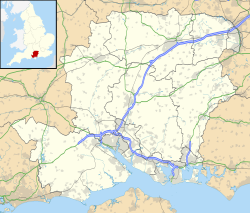Early history
Located near Langstone in Hampshire, [2] a Saxon settlement was established in the 7th century. It is mentioned in the Domesday Book of 1086, [3] indicating a population of about 120. [4]
The owner of the property at the time was Roger, Earl of Shrewsbury; after his death in 1094, it was inherited by his second son, Hugh. The owner in 1186 was William de Courci. [5]
Some sources claim that the manor received a licence to crenellate in 1340 [6] but this is disputed. [7] The manor passed through several hands before coming into the possession of Richard Neville, 16th Earl of Warwick, in the 15th century. [8] The villagers were subsequently removed, the land becoming a private deer park for Neville. [4]
With the execution of Edward Plantagenet, 17th Earl of Warwick, by Henry VII, the manor passed to the crown. [8] In 1513 Henry VIII gave the manor to Margaret Pole, Countess of Salisbury, who had a new moated manor built [8] between 1515 and 1525. [6]
After Margaret Pole was attainted for treason, temporary grants of the manor were made to William FitzWilliam, 1st Earl of Southampton, and Thomas Wriothesley, 1st Earl of Southampton. [2] Henry VIII then granted the manor to Sir Richard Cotton. [9] On 28 October 1551, Mary of Guise, the widow of James V of Scotland, stayed a night in the castle as the guest of Sir Richard Cotton. [10] [11] Edward VI visited the "fair house of Sir Richard Cotton" in August 1552. [12]
Elizabeth I may have visited for two days in 1586. [2] George Cotton of Warblington was a Catholic recusant, visited by priests including Thomas Lister alias Butler in 1603, and in 1613 a reliquary of a martyr Mark Barkworth was found in John Cotton's study. [13] The Cotton family continued to hold the house until the English civil war. [9]
In January 1643 Parliamentarians under Colonel Richard Norton of Southwick Park garrisoned the house with a force of between 40 and 80 men. [9] It was besieged and taken by Ralph Hopton, 1st Baron Hopton, although Colonel Norton managed to escape. [9] [14]
The Cotton family were Royalists, which resulted in the manor being largely demolished by Parliamentarian forces. [9] One turret of the gatehouse was left as an aid to navigation for ships in Langstone channel. [8] The turret is octagonal in form and four stories in height. [2] It is largely built from brick with stone dressing and battlements. [15] After the Stuart Restoration, the property was returned to the Cotton family who built a farmhouse near the ruin. [1] The latter is now Grade II listed. [16]
Today, the turret, the arch of the gate and the drawbridge support in the moat still survive. [6] The land remains private property. [17] The remains of the castle is a grade II* listed building and a scheduled monument. [7] The Listing specifics define it as a "gateway tower, including the moulded stone arch of the gate, some of the south wall of the tower, a complete south-east octagonal stair turret, of 5 storeys, and part of the east wall (facing the courtyard)". [18]
The castle is located within the Warblington Conservation Area which also contains the adjoining Old Farm House, [19] an old cemetery, the Grade I listed St Thomas à Becket Church, Warblington [20] and the Old Rectory. [3]
As of May 2020, the owners of the castle were retired Olympic rowers Tom and Diana Bishop who live in the seven bedroom Old Farm House on the property. [21] At that time, the property also included four acres of gardens, an orchard and a swimming pool. [19]
The tower was notably featured in a scene from Ken Russell's 1975 film of The Who's rock opera Tommy , when Roger Daltrey leapt off the top strapped to a hang glider to the song "Sensation".


